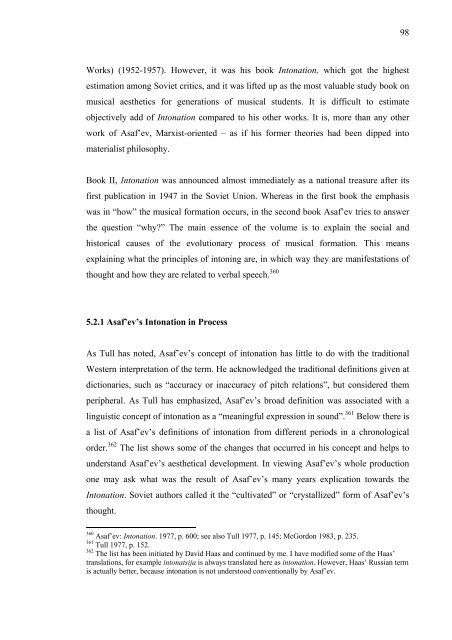Boris Asaf'ev and the Soviet Musicology - E-thesis
Boris Asaf'ev and the Soviet Musicology - E-thesis
Boris Asaf'ev and the Soviet Musicology - E-thesis
Create successful ePaper yourself
Turn your PDF publications into a flip-book with our unique Google optimized e-Paper software.
Works) (1952-1957). However, it was his book Intonation, which got <strong>the</strong> highest<br />
estimation among <strong>Soviet</strong> critics, <strong>and</strong> it was lifted up as <strong>the</strong> most valuable study book on<br />
musical aes<strong>the</strong>tics for generations of musical students. It is difficult to estimate<br />
objectively add of Intonation compared to his o<strong>the</strong>r works. It is, more than any o<strong>the</strong>r<br />
work of Asaf’ev, Marxist-oriented – as if his former <strong>the</strong>ories had been dipped into<br />
materialist philosophy.<br />
Book II, Intonation was announced almost immediately as a national treasure after its<br />
first publication in 1947 in <strong>the</strong> <strong>Soviet</strong> Union. Whereas in <strong>the</strong> first book <strong>the</strong> emphasis<br />
was in “how” <strong>the</strong> musical formation occurs, in <strong>the</strong> second book Asaf’ev tries to answer<br />
<strong>the</strong> question “why?” The main essence of <strong>the</strong> volume is to explain <strong>the</strong> social <strong>and</strong><br />
historical causes of <strong>the</strong> evolutionary process of musical formation. This means<br />
explaining what <strong>the</strong> principles of intoning are, in which way <strong>the</strong>y are manifestations of<br />
thought <strong>and</strong> how <strong>the</strong>y are related to verbal speech. 360<br />
5.2.1 Asaf’ev’s Intonation in Process<br />
As Tull has noted, Asaf’ev’s concept of intonation has little to do with <strong>the</strong> traditional<br />
Western interpretation of <strong>the</strong> term. He acknowledged <strong>the</strong> traditional definitions given at<br />
dictionaries, such as “accuracy or inaccuracy of pitch relations”, but considered <strong>the</strong>m<br />
peripheral. As Tull has emphasized, Asaf’ev’s broad definition was associated with a<br />
linguistic concept of intonation as a “meaningful expression in sound”. 361 Below <strong>the</strong>re is<br />
a list of Asaf’ev’s definitions of intonation from different periods in a chronological<br />
order. 362 The list shows some of <strong>the</strong> changes that occurred in his concept <strong>and</strong> helps to<br />
underst<strong>and</strong> Asaf’ev’s aes<strong>the</strong>tical development. In viewing Asaf’ev’s whole production<br />
one may ask what was <strong>the</strong> result of Asaf’ev’s many years explication towards <strong>the</strong><br />
Intonation. <strong>Soviet</strong> authors called it <strong>the</strong> “cultivated” or “crystallized” form of Asaf’ev’s<br />
thought.<br />
360<br />
Asaf’ev: Intonation. 1977, p. 600; see also Tull 1977, p. 145; McGordon 1983, p. 235.<br />
361<br />
Tull 1977, p. 152.<br />
362<br />
The list has been initiated by David Haas <strong>and</strong> continued by me. I have modified some of <strong>the</strong> Haas’<br />
translations, for example intonatsija is always translated here as intonation. However, Haas’ Russian term<br />
is actually better, because intonation is not understood conventionally by Asaf’ev.<br />
98

















